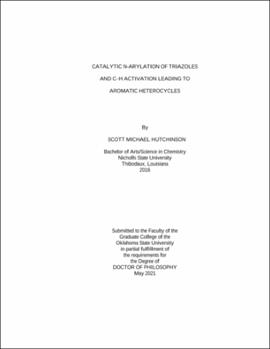| dc.description.abstract | 5-Membered N-heterocycles have become valuable structural motives in organometallic chemistry, organic synthesis, and medicinal chemistry. Such compounds can act as ligands for organometallic complexes and catalysts, as organocatalysts, and are structural components of many FDA-approved pharmaceuticals. We developed a new method for the synthesis of 1-aryl-4-substituted-triazolium salts, employing copper catalysis and diaryliodonium salts. Previously, 1-aryl-4-substituted-triazolium salts were synthesized by a multistep, low-yielding, synthetic pathway. Our arylation procedure progressed in two short steps, first, starting from cheap primary amines converting to the corresponding 4-substituted-1,2,4-triazoles, followed by the copper-catalyzed N-arylation. The arylation of the 4-substituted-triazoles progressed under mild conditions, was tolerant of water and oxygen, and permitted a wide variety of functional groups in moderate to high yields. Further functionalization of our triazolium salts with amine substituents led to the discovery of an alternative approach to fused azoles. Bicyclic azoles were previously synthesized starting from a combination of hydrazonyl halide and thioether substituted azoles or starting from amino or hydrazinyl azoles. Our iodine-promoted cyclization began from 4-(2-nitrophenyl)-1-substituted-4H-1,2,4-triazol-1-ium salts, which were all synthesized from 4-(2-nitrophenyl)-1,2,4-triazole using our arylation procedure and substitution reactions with high yields. Our nitro-containing triazolium salts were reduced and isolated as 4-(2-ammoniophenyl)-1-substituted-4H-1,2,4-triazol-1-ium chlorides in high yields. Finally, subjecting the 4-(2-ammoniophenyl)-1-substituted-4H-1,2,4-triazol-1-ium chlorides to iodine-promoted intramolecular cyclization allowed the synthesis of 9H-benzo[4,5]imidazo[2,1-c][1,2,4]triazol-1-ium salts in low to moderate yields. Our method allowed for a mild sequential synthesis of imidazo[2,1-c][1,2,4]triazol-1-ium salts from primary amines. Overall, we are confident that our procedure will allow access to novel organocatalysts and organometallic ligands, as well as compounds that exhibit biological activity. | |
